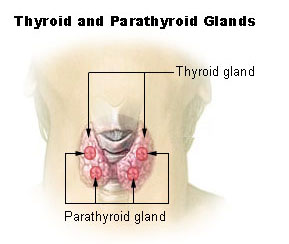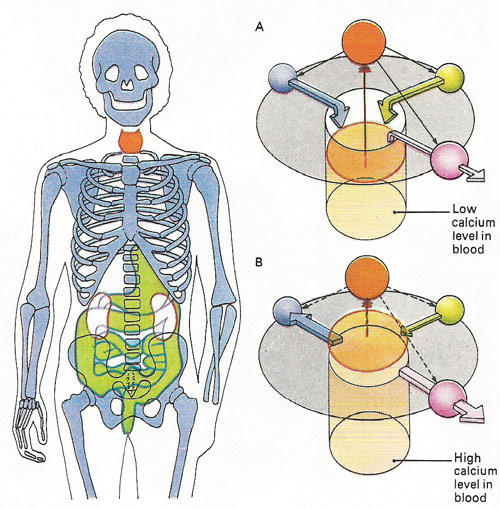parathyroid gland

Figure 1. Thyroid and parathyroid glands.

Figure 2. The hormone produced by the parathyroid glands (orange) abbreviated to PTH, has the important function of regulating the level of calcium in the blood. The mineral itself controls secretion of PTH by means of a feedback mechanism. A low blood-calcium level (A) triggers secretion of PTH. This in turn mobilizes calcium from the bones (blue) and aids its absorption from the intestines (green) and reabsorption from the kidneys (pink) to boost the amount that is circulating in the blood. With a high blood-calcium level (B) the sequence is reversed. Production of the parathyroid hormone is inhibited and consequently more calcium is laid down in the bones of the body.
A parathyroid gland is one of four small, yellowish-brown, pea-like masses of epithelial tissue that are embedded in the connective tissue capsule on the posterior surface of the thyroid glands (Figure 1). The parathyroid glands are endocrine glands which secrete parathyroid hormone or parathormone. Parathyroid hormone is the most important regulator of blood calcium levels. The hormone is secreted in response to low blood calcium levels, and its effect is to increase those levels.
Hypoparathyroidism, or insufficient secretion of parathyroid hormone, leads to increased nerve excitability. The low blood calcium levels trigger spontaneous and continuous nerve impulses, which then stimulate muscle contraction.
Hyperparathyroidism is the excessive secretion of parathyroid hormone, usually due to a small tumor in one of the parathyroid glands. It results in hypercalcemia.
Parathyroidectomy is the surgical removal of the parathyroid glands, usually as part of the treatment of hyperparathyroidism.
Parathyroid hormone
Parathyroid hormone (PTH) is an 84-amino acid peptide hormone secreted by the parathyroid gland in response to low levels of calcium in the blood (Figure 2). Parathyroid hormone (PTH) acts to maintain normal levels of blood calcium by:
• increasing the number of osteoclasts, cells that break down the bone matrix and release calcium into the blood
• increasing the reabsorption of calcium and magnesium ions in the kidney tubules, so that their concentration is maintained in the blood
• converting vitamin D to its active form, which increases calcium absorption in the intestine.
Parathyroid hormone acts in opposition to calcitonin.


